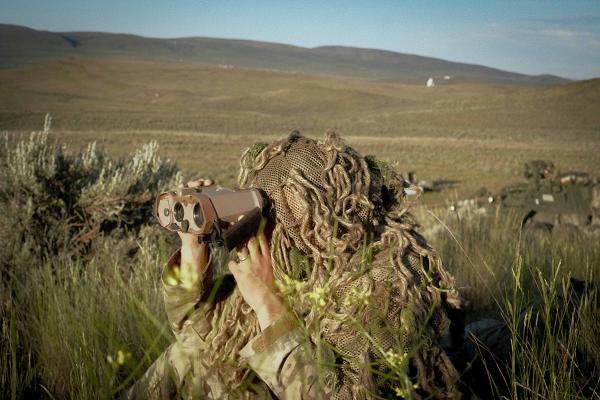
Yakima Training Center, Washington. (July 19, 2024): When they absolutely, positively don’t want to be spotted, America’s warfighters depend on the camouflage provided by the famous Ghillie suit. In this photo by Army National Guard Sergeant Remi Milslagle, Specialist Mackenzie Jones blends into his surroundings while participating in a live-fire range exercise.
The word “ghillie” comes from the Scottish gille or outdoor servant. The name likely referred to attendants that assisted sportsman with recreational shooting. The Scotts themselves prefer to credit the Ghillie Dhu, an earth spirit covered with moss to conceal itself. The first recorded use of the Ghillie suit in combat was during the English Boer Wars in South Africa at the turn of the century and it was quickly adopted by the first English sniper units.
Modern Ghillie suits are a type of camouflage clothing designed to resemble the surrounding environment such as foliage, snow, or sand. The suit “breaks up the profile” of a shooter by creating a three-dimensional image that moves in the wind the same as the surrounding foliage. These suits are typically made of netting or cloth covered in loose strips of burlap made to look like leaves or twigs and augmented with scraps of live foliage.
Although an excellent camouflage tool, the Ghillie suit has its disadvantages. First, the suit is extremely heavy and can be ridiculously hot. Even in moderate climates, temperatures inside a Ghillie can reach 122 degrees. Moreover, the fabric retains water which dramatically increases its weight. The military is experimenting with a more light, breathable material to address the problem.
Another drawback is the burlap used to create the suit is flammable and at risk from ignition sources like smoke grenades. To help solve this issue, the Army is developing a fire-resistant, self-extinguishing fabric to replace flammable burlap. Finally, conventional Gillies do not conceal a warfighter from the infrared spectrum, so they are highly detectable using night vision devices.
Just remember when you simply must blend in… nothing beats the Ghillie suit.


